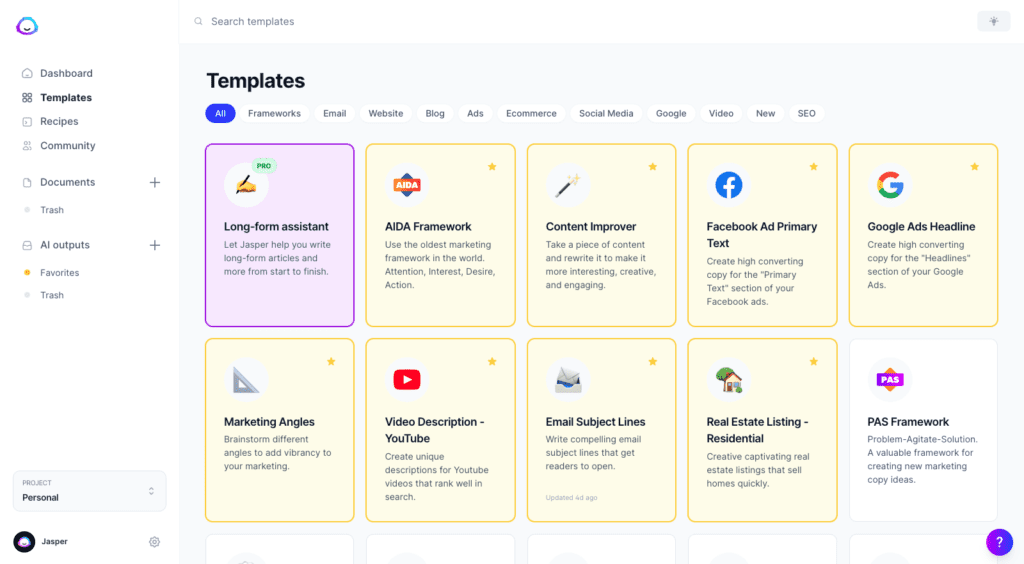
Jasper AI Review: Can a Robot Write Great Content?
Is Jasper the future of content creation? That’s what many people are asking themselves since this AI writing tool began making waves in the online marketing world. But does its promises of high-quality content in minutes hold true? Let’s take a look at this artificial intelligence tool…
Disclosure: This post contains affiliate links. As an affiliate, I earn a commission on qualifying purchases.
What is Jasper?
Jasper is an artificial intelligence (AI) tool that is designed for bloggers, copywriters, freelance writers, and other online marketers. In my opinion, it’s the best on the market for these professionals (and you’ll see more about why in the demo below).
At its core, artificial intelligence refers to a computer process that can execute results similar to human thinking or human decisions. AI writers are able to produce content that is very similar to human writing.
For its AI technology, Jasper relies on GPT-3. This is an autoregressive language model which was was trained on 10% of the internet during its development. It has billions of learning parameters that allow it to create language that parallels human writing.
Jasper uses this technology to create content on demand, based on prompts given by the user. You can use Jasper for…
- Blog posts – generate AI content for your blog based on a topic, headline, or keyword.
- Social media posts – create social media marketing copy to help you promote your brand.
- Sales pages and landing pages – find the right words to sell your products and services online.
- Lead magnets – generate opt-in offers like email newsletters, video presentation scripts, and more.
- Product descriptions – add product details in an engaging format that will get people to buy.
- Advertising copy (Google ads/Facebook ads) – come up with creative ad copy that resonates with users without spending hours brainstorming ideas yourself.
This is by no means an exhaustive list. In the Jasper Facebook Group, I remember one family that used Jasper to allow their kiddo to write a full children’s book. How fun is that?!
Here’s a quick glimpse at just a few of the templates available in Jasper:

What Jasper IS and ISN’T
As a full-time blogger with five different sites, Jasper has become instrumental in helping save time on creating content.
Before I dive into how to actually create blog posts, though, I want to be clear – Jasper is not a complete substitute for a human writer. For the best content, you need human eyes looking over what Jasper puts out, adding interesting viewpoints, optimizing for SEO, and adjusting for accuracy.
I often see people in Facebook groups saying that AI content is “crap” and won’t rank. If all you do is throw a keyword into Jasper, press the compose button a bunch of times, and slap up whatever it spits out five minutes later – of course you’re going to be disappointed with your results.
But if you use it as it’s intended – as a writing assistant; a tool that helps you create content that you refine – you’ll find that it reduces mental fatigue and saves you a ton of time.
Also, to clear up the SEO confusion – I personally have many Jasper-assisted blog posts that are ranking on page one right now. AI-assisted content can most definitely rank well if it is high-quality content. Here is just one example from a recent post that was written in less than an hour total using the tool:

How to use Jasper to Write High-Ranking Blog Posts
Let’s walk through exactly how you can use Jasper to create high-ranking blog posts (and you’ll find a video demo below this that showcases the first few steps visually).
Step 1: Do keyword research.
One of the biggest mistakes that many new bloggers make is not understanding keyword research. Proper keyword research is essential to choosing the right topics to write about. If you choose a super competitive topic, or a topic that no one is looking for – using Jasper won’t matter regardless.
There are many keyword research tools on the market that can help you find decent volume, low competition keywords. My personal favorite (especially for those on a budget) is KeySearch. Be sure to read the guide to using KeySearch to choose keywords, as I go into much more depth there on how to use that tool.
But essentially, you’ll type potential topic ideas into KeySearch and look through the related keywords section to find the best keyword options for you, balancing volume and competition.
Step 2: Choose a good topic for AI.
After you’ve got a list of potential keyword ideas, choose one that will work well for an AI writer. In my experience, that includes:
- List-style posts (i.e. “10 healthy afterschool snack ideas”)
- How-to posts (i.e. “How to write an SEO optimized blog post”)
- Topic-based posts that aren’t extremely technical or don’t require in-depth research (i.e. “What to eat before your next road race”)
- Persuasive posts (i.e. “Why you need to try an aerial yoga class”)
I’ve found that Jasper is not well-suited for post topics that focus on emerging research or scientific topics that require high levels of accuracy. For example, if you’re writing a post about the latest research in intermittent fasting and diabetes, you’re probably going to need to write the bulk of that yourself by curating the research highlights you wish to include.

Step 3: Use the blog post workflow in Jasper.
Here, you’ll type in a brief content description and (optional) keyword. Jasper will use that to generate title ideas, providing tons of catchy options.
From there, it’ll generate three potential intro paragraphs. You can always ask it to generate more if you don’t like any of the first three.
Once you’ve selected your intro, you’ll open up the long form editor and start working on the rest of your content!
I usually start by coming up with a basic outline of my H2 headings, based on what I know I want to cover. But you could also just hit the compose button and see what Jasper comes up with first. This can give you a few ideas and get the creative wheels spinning.
Once I outline with the H2s, I’ll let Jasper create the content for each section. If he seems to be veering off course, I’ll guide him by adding a sentence or two of my own to get it moving in the right direction.
Step 4: Edit the post.
Once you’ve got a draft of the blog post with Jasper, it’s time to edit. There are four components to this process:
- Add onto what Jasper wrote. This can be your own unique experiences with the topic, research that you discovered, or other interesting facts or stories. You might also add unique images or videos. The key is to make the post the best it could be and give it your own flair, so it’s not just another piece of regurgitated Internet content.
- Fact check what Jasper wrote. Jasper is a writing assistant, not a researcher or fact checker. Sometimes he will just blatantly make up stuff. Fact checking is a 100% necessary part of the process. (Which hopefully, if you’re writing about a topic you’ve got expertise in, will be pretty quick and easy).
- Edit for SEO. You’ll also want to make any necessary SEO edits. This includes ensuring your keyword is in the title, intro, and in the post itself. You’ll also want to make sure there are common variations of the keyword, as well as core topics associated with the keyword, in the post. Honestly, if you write a great post, you’re likely to be doing these things anyway. (Some people will use SEO tools like Frase or Surfer to help optimize; those can be useful if you aren’t comfortable with SEO-optimized writing).
- Run the content through a plagiarism checker. Once you’ve got the draft finalized, pop that into a plagiarism checker like CopyScape or QueText. Jasper should generate completely unique content, but there’s always the rare chance that the combination of words generated in AI happen to match another piece of writing. Be sure to always check for this before publishing.
Step 5: Publish and link!
Once you’ve hit publish, sit back and relax knowing that Google will start indexing your post shortly (the specific time frame varies, but generally in as little as several hours to as long as a couple weeks).
When you do publish, you can help SEO by interlinking to the new post from any older, relevant posts. You can also try to build backlinks to this new post from other websites, through strategies like HARO, blogger roundup groups, or strategic outreach.
Now all that’s left to do is watch that traffic start rolling in. 😉
Demo Video
Curious to see what this process actually looks like? Let me walk you through some of the information I shared above using KeySearch and Jasper together.
Pros and Cons
Like any tool, there are pros and cons to purchasing. Here’s my quick take:
Pros:
- Easy way to create more content with less mental effort
- Good quality output, especially when guided by you as the user
- Creates written sentences similar to how a human would construct them
- Lightening fast user experience – no long lags or wait times during use
- Ability to create multiple types of content – blogs, social posts, product descriptions, etc.
- Now has a built-in plagiarism checker that you can use (additional fee but very inexpensive)
- Offers a free 5-day trial to test it out
- Available for multiple languages
Cons:
- Jasper sometimes writes irrelevant or repetitive information (you need to learn how to guide him and make sure to fact check)
- There is a slight learning curve involved with figuring out best practices (but the Jasper team has a ton of training videos)
- Cost can be prohibitive for newer writers (though pricing structures have changed)
- The tool is only available to use on desktop; there’s no current mobile application
Pricing
There are two different plans you can purchase on Jasper:
- Starter plan – Pricing starts at $29/month for 20,000 words of AI-generated short-form content. I don’t recommend this plan because you won’t have the long form document editor.
- Boss mode plan – Pricing starts at $59/month for 50,000 words of AI-generated content. You can buy more words if needed.
What exactly counts as a word of AI-generated content? Anything the AI is processing or producing. If you hit the compose button and Jasper produces 300 words, that goes towards your limit.
Words you delete do apply to the word totals; however currently they offer the ability to receive a credit for up to 20% of your plan’s word limit (so if you get a bunch of gibberish, you can downvote that output and get those words “refunded”). Information about this policy is on this support page.
Jasper vs. Other AI Tools
I’ve personally tested a whole bunch of different AI writing tools in addition to Jasper – and continuously find that the high-quality outputs and speed of Jasper puts it ahead of the rest. You can read more about some of these other tools and their features in this post about artificial intelligence for bloggers.
Is Jasper the future of content creation?
I think artificial intelligence – including tools like Jasper – will only continue to grow as part of the content creation space.
Not only does Jasper offer a time-saving solution for content writing, but it helps reduce the mental fatigue that’s so often accompanied with lots of writing each week.
Want to try it yourself? Grab a free trial of Jasper and let me know what you think!
Share: Have you ever used Jasper? What did you think?
Feel free to pin this post to share with others. 🙂





